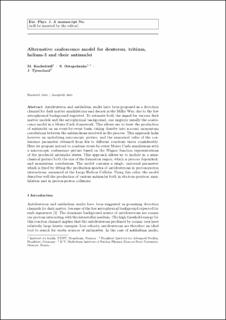| dc.contributor.author | Kachelriess, Michael | |
| dc.contributor.author | Ostapchenko, Sergey | |
| dc.contributor.author | Tjemsland, Jonas | |
| dc.date.accessioned | 2021-02-16T09:54:05Z | |
| dc.date.available | 2021-02-16T09:54:05Z | |
| dc.date.created | 2020-04-30T15:06:49Z | |
| dc.date.issued | 2020 | |
| dc.identifier.citation | European Physical Journal A. 2020, 56 . | en_US |
| dc.identifier.issn | 1434-6001 | |
| dc.identifier.uri | https://hdl.handle.net/11250/2728290 | |
| dc.description.abstract | Antideuteron and antihelium nuclei have been proposed as a detection channel for dark matter annihilations and decays in the Milky Way, due to the low astrophysical background expected. To estimate both the signal for various dark matter models and the astrophysical background, one usually employs the coalescence model in a Monte Carlo framework. This allows one to treat the production of antinuclei on an event-by-event basis, thereby taking into account momentum correlations between the antinucleons involved in the process. This approach lacks, however, an underlying microscopic picture, and the numerical value of the coalescence parameter obtained from fits to different reactions varies considerably. Here we propose instead to combine event-by-event Monte Carlo simulations with a microscopic coalescence picture based on the Wigner function representations of the produced antinuclei states. This approach allows us to include in a semi-classical picture both the size of the formation region, which is process dependent, and the momentum correlations. The model contains a single, universal parameter which is fixed by fitting the production spectra of antideuterons in proton–proton interactions, measured at the Large Hadron Collider. Using this value, the model describes well the production of various antinuclei both in electron–positron annihilation and in proton–proton collisions. | en_US |
| dc.language.iso | eng | en_US |
| dc.publisher | Springer | en_US |
| dc.title | Alternative coalescence model for deuteron, tritium, helium-3 and their antinuclei | en_US |
| dc.type | Peer reviewed | en_US |
| dc.type | Journal article | en_US |
| dc.description.version | acceptedVersion | en_US |
| dc.source.pagenumber | 12 | en_US |
| dc.source.volume | 56 | en_US |
| dc.source.journal | European Physical Journal A | en_US |
| dc.identifier.doi | 10.1140/epja/s10050-019-00007-9 | |
| dc.identifier.cristin | 1808900 | |
| dc.description.localcode | "This is a post-peer-review, pre-copyedit version of an article. The final authenticated version is available online at: https://doi.org/10.1140/epja/s10050-019-00007-9 | en_US |
| cristin.ispublished | true | |
| cristin.fulltext | postprint | |
| cristin.qualitycode | 1 | |
